Highlights
- Men without high school diplomas are about 20 percentage points more likely than all other men to have gone without sex for at least a year. Post This
- Two groups of female respondents—college-educated women in their 20s and, especially, women over age 35—are most likely to be stakeholders in the sex recession. Post This
It’s well established that Americans are having less sex. In a recent post for IFS, I explored whether this trend has been gathering steam—if the sex recession was turning into a great sex depression. The results were equivocal: 2018 was a bad year for sex in America, but there’s little evidence that more Americans have foresworn sex over the past decade.
My post examined sex data from two national data sets. Much of the research to date on the sex recession has been based on the General Social Survey, a reliable but somewhat limited source of sex data. I contrasted GSS statistics with data from the National Survey of Family Growth. The NSFG, a biennial survey of about 9,000 people, has detailed sex data, as well as a wide-ranging selection of covariates. The current post considers what kinds of Americans are especially prone to be caught up in the sex recession.
As in my previous post, I analyze data from the past four waves of the NSFG, spanning the years 2011 to 2019, exploring both year-long celibacy for men and women, and longer intervals of sexlessness for women. People in live-in relationships are rarely celibate, so this analysis looks at people who aren’t married or cohabiting. Year-long celibacy is defined as the absence of any oral, anal, or vaginal contact. Data limitations relegate the measurement of long-term celibacy to the incidence of women’s coitus. Finally, my analysis only looks at heterosexual celibacy, as the NSFG doesn’t measure marital status or cohabitation for same-sex unions.1
Race/Ethnicity
There are substantial demographic differences in the populations most likely to go without sex. As Figure 1 shows, the differences are especially large by race/ethnicity. African Americans are least likely to be celibate, while survey respondents in the “other” group—most often Asian Americans—are most likely.2 The difference is substantial, with Blacks about half as likely to be celibate for a year or longer than are Asian Americans and others. The “other” group also has the largest gender disparity, with over a third of other women reporting a year or more of no sex. Finally, the two- and five-year differences by race/ethnicity follow the same pattern as the differences shown in Figure 1, so they’re omitted in the interest of brevity.
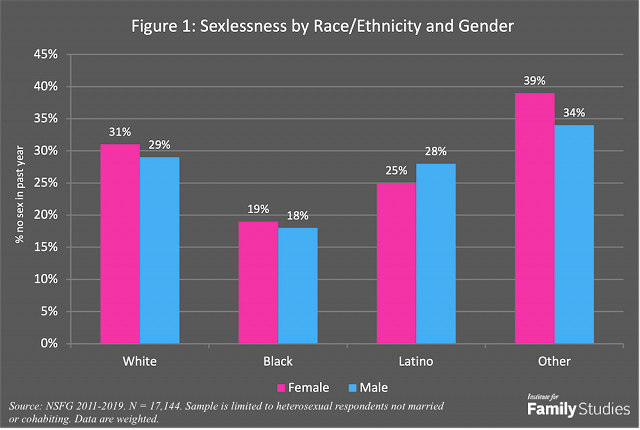
Age and Education
Predictably there are large disparities by age, with older respondents most likely to have been celibate for a year or more (Figure 2). At about 20%, sexlessness is lowest for respondents between the ages of 25 and 34. Thereafter the chances of celibacy steadily increase, as does a large gender gap. There’s no such gap for Americans younger than 34, but past that, the odds of sexlessness rise much more quickly for women. By ages 45-49, 40% of single women are celibate but under 30% of single men.3
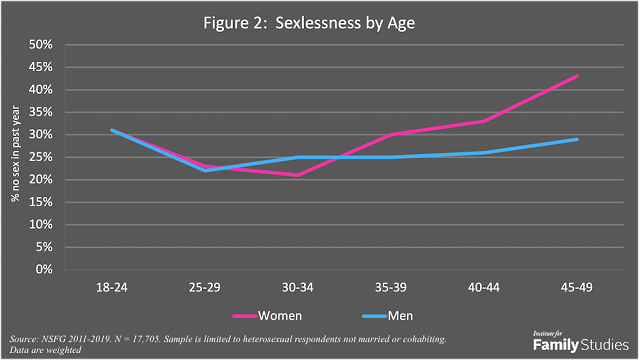
Older women are also disproportionately prone to long-term celibacy, as Figure 3 shows. Over one in three women in the 45-49 age group have gone two years without a sex partner, while one in five women has been celibate for five or more years. At this point it’s not unreasonable to suspect that celibacy will be permanent for many of these women.
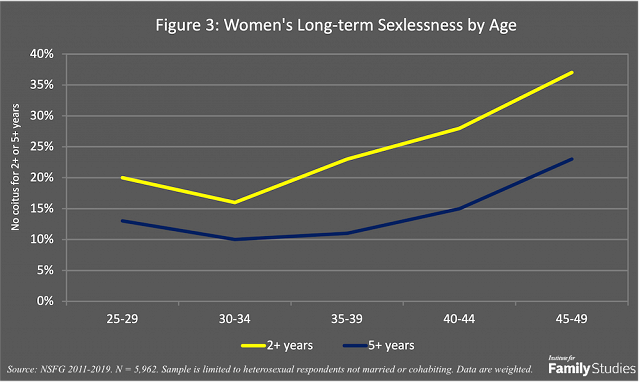
Preliminary analysis showed that the effects of education on celibacy vary substantially by age, so I explore them together. Compared to age, education mostly produces more modest variation in celibacy. Still, some of the differences shown in Figure 4 are noteworthy. In particular, women in their 20s with four-year college degrees are up to ten percentage points more likely to be celibate compared to their age peers without degrees. I and other scholars have long observed that some women who pursue high-flying careers do so at the expense of family formation, a compromise that men are less likely to strike. So it makes sense that these women are more likely to be celibate for a year or more while they are in college or graduate school, or establishing themselves professionally. The high celibacy rate for 20-something college-educated women also accords with the research showing that only a minority of women do a lot of hooking up in college.
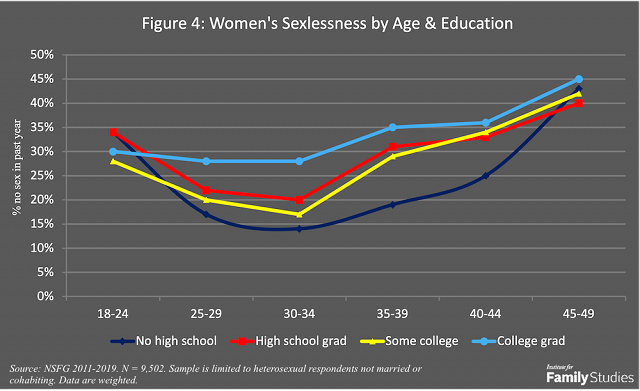
The trend towards youthful celibacy for college-educated women is especially apparent when we consider long-term sexlessness in Figure 5. College-educated women in their mid to late 20s are almost three times as likely as other women to have been celibate for five or more years compared to other women in their age group, although long-term celibacy is broadly uncommon for women in their 20s. Long-term sexlessness continues to be more common for women with college degrees in their 30s, but this pattern reverses itself for women in their 40s. By ages 45-49, high school graduates and high school dropouts are five or more percentage points likely to have gone five years without coitus.

Celibacy trends differently for men. On the whole, Figure 6 shows relatively little variation in men’s sexlessness by age or education, especially compared to women. Like women, college-educated men are a little more likely to go sexless in their late twenties (perhaps this is contributing to secular declines in male promiscuity, particularly for college-educated men). But there is one glaring exception shown in Figure 6: the sharp spike in sexlessness for men without high school diplomas ages 45 to 50. These men are about 20 percentage points more likely than all other men to have gone without sex for at least a year.

This is a startling finding. These men—high school dropouts in their mid to late forties—are smack in the middle of the “deaths of despair” demographic: white men with deteriorating attachments to the labor force, to marriage, and to social institutions in general, and whose life expectancy has fallen in recent years. Based on the NSFG data, it appears that these men are also experiencing a stark withdrawal from the primordial human connectedness of sex.
Academics are trained to attach caveats to their findings, and I’m no exception. Only the last two waves of the NSFG included respondents in the 45-50 age range. This produces exactly 75 men without high school diplomas, and respondents over age 45 aren’t in the portion of the sample that’s fully representative. More research is needed to uphold this result, even if it does accord with what we know about how some middle-aged Americans without college diplomas have been faring in recent years.
Religion
There are several other factors that produce large differences in celibacy rates. As might be expected, religious Americans are more likely to experience long periods of celibacy than are their less religious contemporaries. As Figure 7 shows, both men and women who attend services regularly—several times a month or more—are substantially more likely to have been without sex for a year or more compared to their less observant peers. Moreover, there is little gender difference in the relationship between devotion and celibacy. And the relationship extends to longer periods of celibacy for women: regular attendance at church, synagogue, or a mosque is associated with sexlessness at two and years (result not shown).
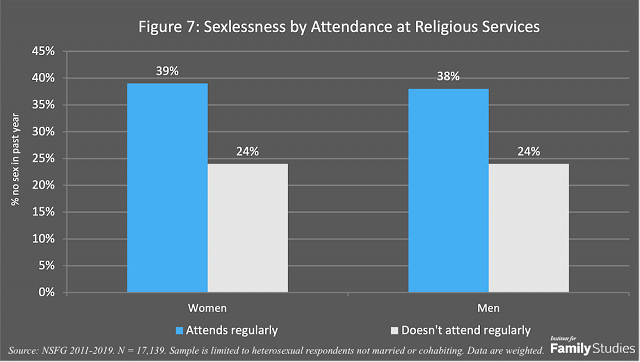
Figure 8 shows that the relationship between religion and celibacy extends to religious denomination.4 At almost 40%, the highest rate of sexlessness accords to Americans claiming “other” denomination. This classification includes Jehovah’s Witnesses, Mormons, Muslims, and Orthodox Jews, all socially conservative faiths. Close behind other denominations are evangelical Protestants, at about 35 percent. At the other end of the continuum, only about 15% of Black Protestants have gone a year without sex. As we have seen, this presumably reflects a racial/ethnic difference, not a denominational effect. Mainline Protestants, Catholics, and the religiously unaffiliated are in the middle of the celibacy distribution. Finally, all of these distinctions are reproduced in the distribution of heterosexual women’s two- and five-year celibacy (result not shown).
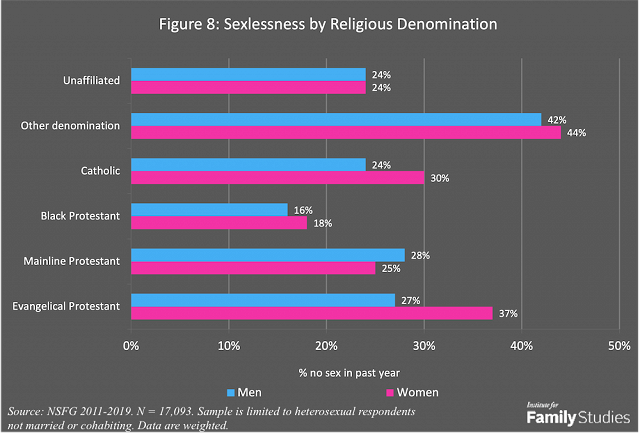
Sexual History
Perhaps the most clear-cut predictor of sexlessness is sexual history, as Figure 9 shows. Simply put, people with many previous sex partners are unlikely to remain celibate. Over 30% of men and women with only one lifetime sex partner have been celibate for a year or more. This figure drops to under 10% for survey respondents with 10 or more partners, with no appreciable gender difference. It seems understandable that men and women inclined to sexual variety aren’t likely to go without.
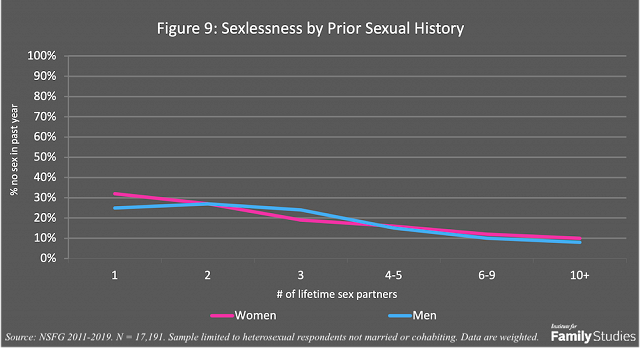
And they’re not likely to remain sexless for longer periods of time, either. Figure 10 shows how previous partners influence the chances of women remaining sexless for two years and five years. Twenty percent of women with only one lifetime partner have remained celibate for more than two years. This declines to under 10% for women who’ve had 10 or more partners. Similarly, 10% of women with one lifetime partner have been celibate for five or more years, but only three percent of women with six or more previous partners. These numbers cast doubt on the notion that people, especially heterosexual women, who’ve been on the market for long periods of time give up on dating out of frustration.
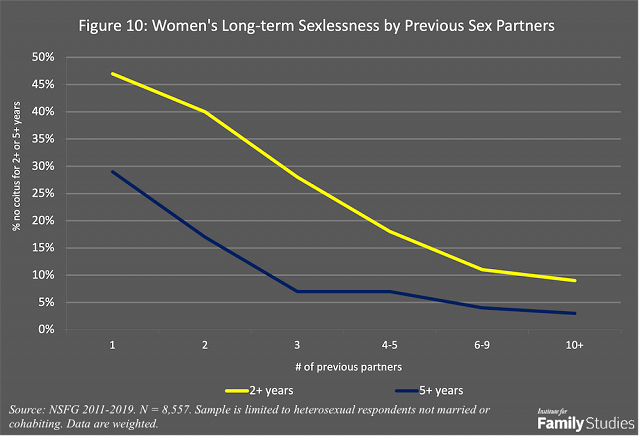
Employment
In 2017, I showed that married women with unemployed husbands were 11 percentage points less likely to have sex at least once a week compared to wives with employed husbands. Here’s what I wrote:
Numerous studies have shown that being out of work takes a harsh toll on men’s self-esteem. Men often see themselves as breadwinners, so when they’re unable to support their families their self-image consequently plummets. It’s not surprising that men suffering joblessness feel less amorous.
What’s more, single men without jobs face the hardship of not being able to pay for dates. With all this in mind, it’s not surprising that men who are out of the paid labor force are 13 percentage points more likely to report at least a year of celibacy (Figure 11). And the same dynamics seem to hold for women as well, although the effect of joblessness on women isn’t quite as large (8 points). Finally, the relationship between employment and women’s long-term celibacy is minimal (result not shown), although this may just reflect the cross-sectional nature of the NSFG data.
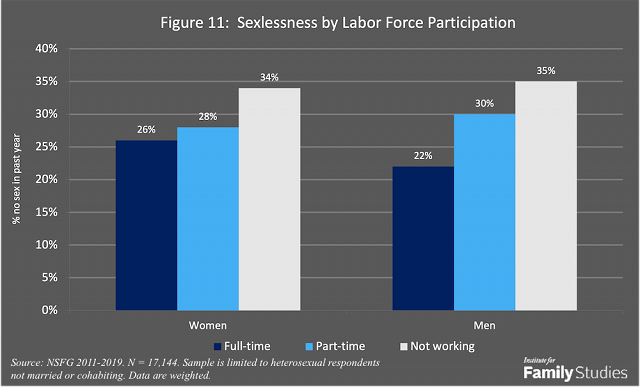
Family Structure of Origin
My first book, Understanding the Divorce Cycle: The Children of Divorce in their Own Marriages, explored how parental divorce affects adult offspring in their own relationships. My research led me to suspect that family structure would have a large effect on adult sexlessness. When I published my book in 2005, it was well established that kids from divorced families lost their virginity more quickly and were also more likely to be dating as young adults. That having been said, my research has also shown that some of the effects of family structure on adult offspring have weakened over time (with these findings updated in an IFS brief a few years ago).
The NSFG data are consistent with what we already know about the effects of parental divorce. Figure 12 shows that women from intact families are 50% more likely—34% vs. 22%—to have been sexless for a year or more, while men from intact families are almost one third more likely—30% vs. 23%—to be celibate. Furthermore, this pattern extends to women’s long-term heterosexual celibacy (Figure 13). Women from intact families are notably more likely to have been celibate for two years, and for five years.
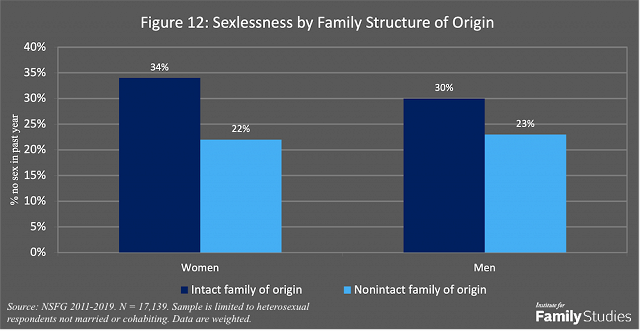
A full explanation of this startling contrast is beyond the scope of this research brief (and likely beyond the scope of the NSFG). Perhaps early sexual debut just gets the children of divorce into the habit of regular sex. It’s also worth noting that a minority proportion of the transmission of divorce between generations is purely genetic in origin. It’s not much of a stretch to suspect that the genetic factors that lead to marital instability may affect interpersonal relationships more broadly.
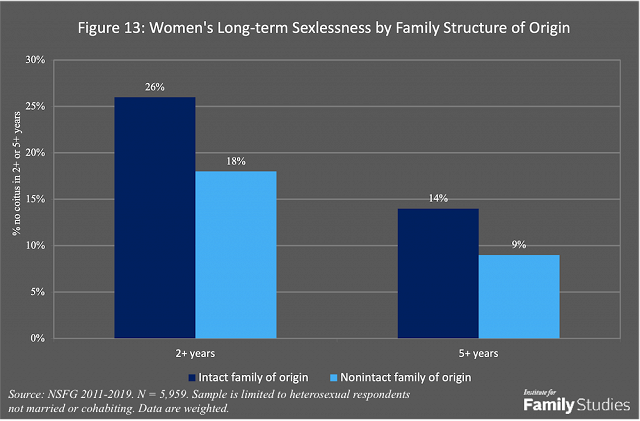
Conclusion
Although the sex recession hasn’t become a great sex depression over the past decade, a substantial minority of single Americans have gone a year or more without intimate relations with another human being. This post has described what segments of the population are most likely to be foregoing sex.
These findings are particularly applicable to women. Two groups of female respondents—college-educated women in their 20s and, especially, women over the age of 35—are most likely to be stakeholders in the sex recession. And for older women, it’s not outside the realm of possibility that celibacy may become a lifelong condition. This may also be a possibility for older men without high school diplomas.
Other findings described here are more predictable. It’s not surprising that unmarried religious adults are more likely to go without sex, while people in the habit of multiple partners more rarely fall into the sex recession.
Why does it matter? Sex is a fundamental part of enduring relationships, and the primary way that children come into the world. And, of course, sex is also fun. At the same time, we should acknowledge that unwanted pregnancies and teen pregnancies are on the decline, as is sexual assault.
Rates of celibacy rose sharply in 2018, and pandemic-stricken 2020 likely failed to buck the trend. In the years to come, sex researchers might look back on these findings and the demographic groups most likely to be celibate, especially older women and older men without college degrees, if the sex recession eventually turns into a great sex depression.
Nicholas H. Wolfinger is Professor of Family and Consumer Studies and Adjunct Professor of Sociology at the University of Utah. His most recent book is Soul Mates: Religion, Sex, Children, and Marriage among African Americans and Latinos, coauthored with W. Bradford Wilcox (Oxford University Press, 2016). Follow him on Twitter at @NickWolfinger.
Editor’s Note: The opinions expressed in this article are those of the author and do not necessarily reflect the official policy or viewpoint of the Institute for Family Studies.
1. Analyses exclude respondents who fall into either of two overlapping measures of sexual orientation: 1) same-sex but not opposite-sex partners in the past year; or 2) had no opposite sex partners in the past year and more lifetime same-sex partners than opposite-sex partners. In recent years more women (but not men) have identified as bisexual and/or had sex with both men and women, so an expansive definition of sexual preference seems warranted.
2. The “other” race/ethnicity category is the NSFG’s, not mine.
3. The weights are omitted for respondents aged 40 and up, as they remove all individuals in the 45-49 category from the analysis. For other age groups the weights increase the estimate of sexlessness by about two percentage points, so the 40-49 figures presented here err on the low side.
4. Denomination is closely related to attendance at religious services. Evangelical Protestants, for instance, attend much more frequently than do Catholics. What’s more, attendance tends to be a stronger predictor of behavior than does denomination, as IFS head W. Bradford Wilcox and I have repeatedly shown. Accordingly I computed Figure 8 estimates that controlled for attendance at services. The results were similar, so they’re not shown here.














